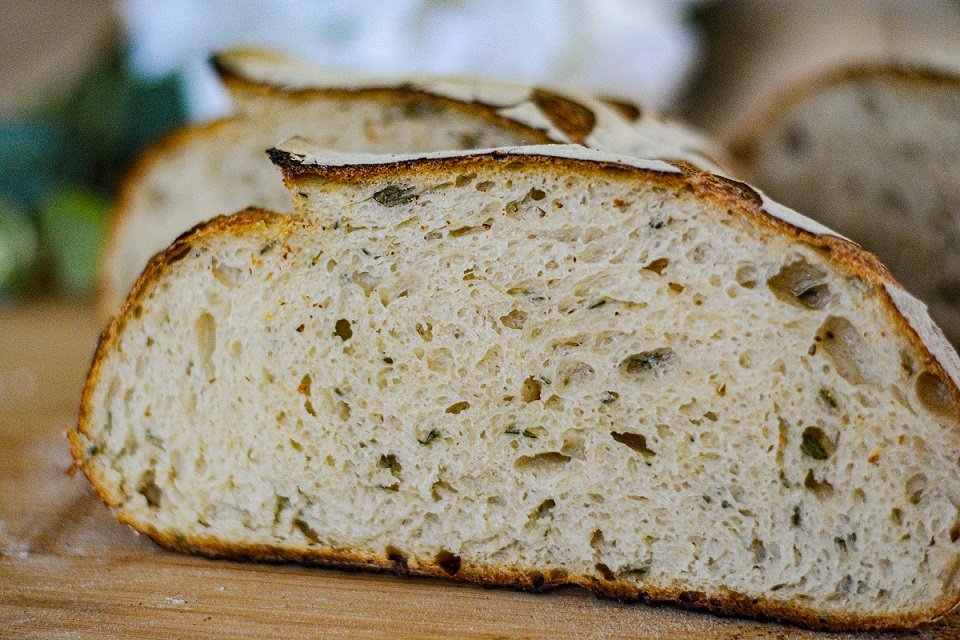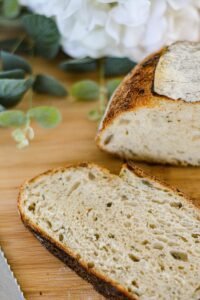This Sage/Garlic sourdough bread recipe screams THANKSGIVING. I have to say though that a couple of weeks ago I asked through an instagram post what were some Thanksgiving flavors and a lot of people mentioned Sage!
So I took the inspiration and added some roasted garlic and voila!
I am sharing this because my Thanksgiving sourdough bread orders are sold out! So thank you so much for your support, it is always exciting to see how my community starts appreciating slow fermentation and quality breads.
If you are wondering, I have some baking days every now and then. So if you are local to Lansdale, PA make sure you subscribe to my newsletter to know when I’m baking.
Let’s check out the recipe for this Sage/Garlic sourdough and baker’s math!

Sage/Garlic Sourdough Bread (2 loaves)
| Ingredient | Baker’s Math | Grams |
| Water | 73% | 697 |
| Leaven | 20% | 191 |
| Total Flour | 100% | 955 |
| Bread Flour | 90% | 859 |
| Whole wheat | 10% | 95 |
| Roasted Garlic | 3% | 29 |
| Sage | 1% | 10 |
| Salt | 2% | 19 |
| Total | 199% | 1,900.00 |
What type of bread flour do I use to make this Sage/Garlic Sourdough Bread?
I always use King Arthur Flour. It’s a brand you can find at mostly any store and it’s of a good quality. It’s also been never bleached and bromated which is very important when working with a sourdough starter.
How do I roast the garlic?
I put the garlic cloves in some aluminum paper and roast them in the oven at 420°F from 20-30 minutes. You want them to be golden brown but soft.
Should I use fresh Sage or dry to make this Sage/Garlic sourdough bread?
I always like to use fresh herbs as the flavor and aromas these give out are stronger! but feel free to use dry if you don’t have anything else.
What ratios should I feed my starter to have it ready to mix the dough?
I always recommend feeding your sourdough starter in a ratio of 100x:100x:10x around 12 hours before you plan to mix the dough. For 2 loaves you should feed it at least the below amount of grams.
*Remember you always want to make extra to save some grams!
- 150 grams of flour
- 150 grams of water
- 15 grams of starter
What water temperature is the ideal for make this roasted garlic&sage sourdough bread?
Just room temperature water is fine. Don’t use warm or hot water as you will accelerate the fermentation process too much.
If you have any questions about your sourdough starter please check out some blog posts that might help you here

Roasted Garlic & Sage Sourdough Bread
Equipment
- Medium size bowl
- Digital Scale
- Scraper
- Parchment Paper
- Scoring knife/razor blade
- Dutch Oven (at least 5qt)
- 2 Bannetons 8'inch (round or oval)
Ingredients
- 860 grams Bread flour
- 95 grams Whole wheat flour
- 697 grams Water
- 191 grams Leaven ripe sourdough starter
- 19 grams Salt fine
- 29 grams Roasted garlic
- 10 grams Sage
- Few grams of rice flour to sprinkle inside the banneton
Instructions
- 12 hours before you plan to mix this dough feed your sourdough starter according to the instructions provided above
- Once your starter is ripe, which means doubled in size, measure out all the ingredients in separate containers
- Roast the garlic and using a fork mash into a puree once it's done
- Finely chop the fresh sage
- In a bowl mix: flours, water, leaven, sage, roasted, garlic, salt. Mix until there are no lumps and all the flour has been incorporated
- Perform folds every 30 minutes for the next 3-4 hours (depending in your dough's temperature)
- Divide the dough in equal pieces, shape and place each one inside a banneton seam side up. If your banneton doesnt have a liner gently cover with rice flour. If your banneton does have a liner lightly sprinkle rice flour
- Cover the doughs with plastic wrap.*The dough should be at the edge of the banneton. If it's not there yet, let it sit at room temperature or in a warmer spot until it rises that much
- Place your loaves in the refrigerator for at least 12 hours max 48 hours
- Preheat your oven to 475°F with the Dutch Oven inside
- Take 1 loaf at a time out of the refrigerator, flip over parchment, score and place inside the Dutch Oven
- Bake for 20 minutes with the lid on, then remove the lid and bake for an additional 10-15 minutes. Or until your desired crust color
